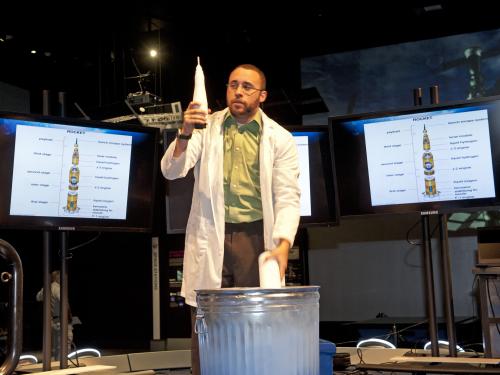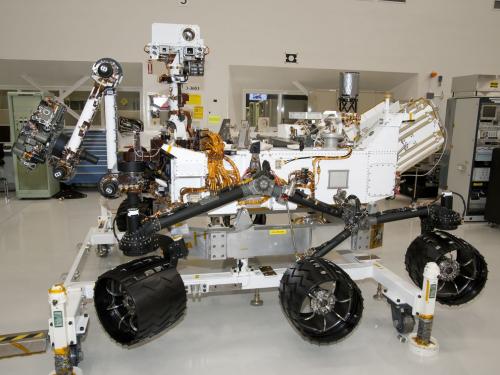
Stories of daring, stories of technological feats, stories of prevailing against the odds ... these are the stories we tell at the National Air and Space Museum. Dive in to the stories below to discover, learn, and be inspired.
Showing 581 - 590 of 634

September 27, 2011
On July 10th, 1962 at 11:47 GMT, the world’s first transmission of a television image by satellite took place, using the Telstar satellite.

August 15, 2011
Learn how Museum educators are using interactive theater presentations to educate visitors about the space shuttle.

August 10, 2011
I had my first glimpse of the end of the shuttle era in April, three months before Atlantis touched down from the final shuttle mission. Discovery had just completed its last flight, and I had an opportunity to visit Orbiter Processing Facility (OPF) Bay 3, which for years had been Discovery’s home for between-mission servicing. Discovery did not return to Bay 3 after STS-133, moving instead into Bay 1 for post-flight work.

August 08, 2011
I was thrilled to be a part of the NASA Tweetup for STS-135 July 7 and 8 at Kennedy Space Center. It was exciting — and almost surreal — to be there for the end of the space program that my generation grew up with. We weren’t around for the Moon landings, but we all remember the first time the space shuttle “took off like a rocket and landed like a plane.”

July 22, 2011
Here is a riddle: What takes more than 60 locations, 5 years, and 150 scientists to decide? The landing site for the Mars Science Laboratory (MSL) rover Curiosity. Picking the landing site for a spacecraft to land on another planet is always serious business. And the job of finding the best location for Curiosity to set down on Mars was no exception. Curiosity’s mission is geared towards understanding whether Mars could have ever been habitable.

July 03, 2011
There is a strange looking car parked in the west end of the National Air and Space Museum in downtown Washington, DC. For now, it is only visible behind its security screen from the second floor landing above. From that vantage, the vehicle’s six wheels, robotic arm, mast, and other protrusions are clearly visible. But since this is the Air and Space Museum, it must be more than just a normal car. Soon the barriers will be gone and the public will be able to view the vehicle up close and personal. And what they will see is a model of the next Mars rover, NASA’s 2011 Mars Science Laboratory. The rover, dubbed “Curiosity” will be launched to Mars later this year and will begin its mission to explore whether places on the Red Planet were ever habitable.

June 17, 2011
For the month of June, 30 beautiful images of the solar system are on display on the terrace by the Independence Avenue entrance. They are part of the From Earth to the Solar System exhibition developed by the Smithsonian Astrophysical Observatory/Chandra with the NASA Astrobiology Institute.

May 20, 2011
Since Howard McCurdy and I co-authored Robots in Space: Technology, Evolution, and Interplanetary Travel (Johns Hopkins University Press, 2008), I have been interested in the possible merger of humans and robots into a single entity to undertake space exploration.

April 05, 2011
On the morning of March 2, I got an excited text message from fellow astronomy educator Shelley Witte, telling me that the International Space Station (ISS) and Space Shuttle Discovery would be coming very close to transiting the Sun from our position at the National Air and Space Museum’s Public Observatory at exactly 3:08 pm.

March 31, 2011
The 2011 Major League Baseball season starts today at 1:05pm, when the National Air and Space Museum’s hometown Washington Nationals host the Atlanta Braves at Nationals Park. This afternoon the red and white uniforms of the Nationals will stand out against the bright green of the field. In the late 1950s, players took to the field of the U.S. Naval Air Material Center in Philadelphia wearing a different uniform—B.F. Goodrich Mark IV spacesuits.